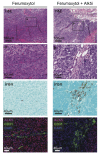Alk5 inhibition increases delivery of macromolecular and protein-bound contrast agents to tumors
- PMID: 27182558
- PMCID: PMC4864003
- DOI: 10.1172/jci.insight.85608
Alk5 inhibition increases delivery of macromolecular and protein-bound contrast agents to tumors
Abstract
Limited transendothelial permeability across tumor microvessels represents a significant bottleneck in the development of tumor-specific diagnostic agents and theranostic drugs. Here, we show an approach to increase transendothelial permeability of macromolecular and nanoparticle-based contrast agents via inhibition of the type I TGF-β receptor, activin-like kinase 5 (Alk5), in tumors. Alk5 inhibition significantly increased tumor contrast agent delivery and enhancement on imaging studies, while healthy organs remained relatively unaffected. Imaging data correlated with significantly decreased tumor interstitial fluid pressure, while tumor vascular density remained unchanged. This immediately clinically translatable concept involving Alk5 inhibitor pretreatment prior to an imaging study could be leveraged for improved tumor delivery of macromolecular and nanoparticle-based imaging probes and, thereby, facilitate development of more sensitive imaging tests for cancer diagnosis, enhanced tumor characterization, and personalized, image-guided therapies.
Figures







References
Grants and funding
LinkOut - more resources
Full Text Sources
Other Literature Sources

